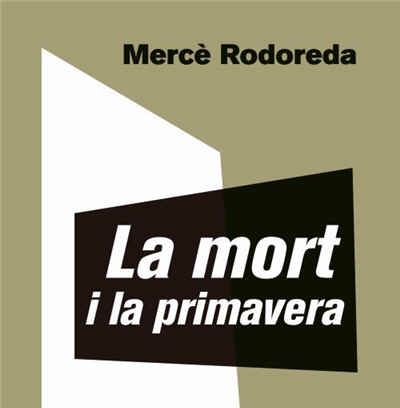La mort i la primavera [Death in Spring] (1986)
Maria Bohigas
“I’m quite intrigued by everything I’ve been told about La mort i la primavera so I’m really keen to read it. Maybe it’s a masterpiece (anything can be expected from the author of La plaça del Diamant [The Time of the Doves]) or maybe it’s all wrong, from start to finish. From what you’ve told me, I fear you might have opted for something unreal, unrelated with flesh-and-blood people and their real problems, by which I mean the exact opposite of La plaça del Diamant”, Joan Sales, Rodoreda’s publisher, wrote to her in December 1961. Unreal, improbable, magical, and even a novel born of delirium, inspired in primitive or exotic peoples, or maybe occult sects, La mort i la primavera seems not to have found a place at the banquet of distinguished Catalan books […].
Not much emphasis tends to be given to the fact that Colometa finds the closest thing to peace with a man who has been castrated by a bullet in the war. Is this very far from the mutilated men in the town of La mort… where every year they choose a man to be thrown into the river, condemning him, if he does not die, to survive as a cripple? The aim of the ritual is to keep law and order in the town, maintaining a regime that has been decreed for once and for all, and that will not tolerate change. Seeking change leads directly to the prisoner’s cage, from which the offender will not be freed until he has lost the power of speech. “The prisoner is whinnying”, the people cry, giving the signal that the danger is over. The man is at last a tamed beast. Imposing an order that must be immutable, sending innocents to their death in order to maintain it, punishing the dissident with dehumanising treatment: are we very far from the real problems of flesh-and-blood people? Rodoreda, Catalan writer in exile, did not get to the Americas. She spent the Second World War in France and, while she was in Paris, witnessed the return of the deportees. What were the problems that she would have considered real?
“Around the people of my time there is an intense circulation of blood and deaths”, she wrote in the Prologue to Quanta, quanta guerra... The beliefs and laws of the town in La mort… revolve around blood and death. The factor that introduces disorder is the way of dying, and the first transgression committed by the main character is against the rite of death. He opens the wardrobes where parents lock the children before going to join the revelry that is part of the ritual of cementing the mouth of a man who is about to die. Desire for his stepmother will then take him, with her, to the forest of the dead in a scene that is reminiscent of the profanation of the tombs in Incerta glòria (Uncertain Glory) and the place of their courtship will be the cemetery of the soulless dead and outlaws. These efforts to defy the order are not exclusive to him as, “for some time now the young people from the wash district had been saying that people should be left to die their own death”, while “the old men from the slaughterhouse argued that everything should continue the way it was before”. Winds of civil war and gusts of totalitarianism blow in La mort… But, without historical and geographic coordinates—or, in other words, features to normalise them—human actions appear as they really are.
Maria Bohigas. “Novel·la del deliri. Mirall sencer”, La Vanguardia, 07/05/2008.




